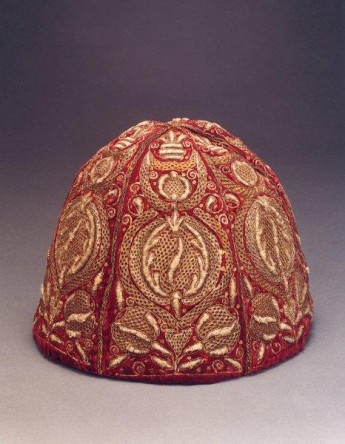Man's Night Cap
- This item was purchased by Burrell Collection, Glasgow
Man's night cap, embroidered in silver and gold thread and gold sequins on dark crimson silk velvet in an oriental style, the cap conical in shape and constructed in six pieces with pomegranate, strawberry and flower motifs. An inscription on paper, attached to the lining, reads ‘This cap belonged Major Buntine, uncle of William Baillie of Monkton. He served under General Lesley in the Civil Wars; and particularly distinguished at Philiphaugh. Cromwell made him Master of Horse in Scotland. Monk sent him to Breda to see Charles II.’ Late-16th or first half of the 17th Century, probably English.
Height 7" (18cm).
Diameter 11" (28cm).
The pomegranate motif was widely employed on clothing and textiles from the 1520s through to the late-17th Century in Europe and the Orient. Pomegranates are indigenous to parts of Asia, but were cultivated and naturalised in the Mediterranean region during the early medieval period and were imported and grown in Britain from the late-16th Century. The motif was particularly popular in England, partly because it was the personal device of Catherine of Aragon and Mary I and partly because the fruit was regarded as a potent symbol of fertility. The heavy, ornate nature of the bullion work is typical of the decoration on items worn or used by a man of fashion in the early-17th Century. Similar work is found on saddles, saddle blankets, frames, caskets, gloves and gambling purses.
The night cap was a round, close-fitting hat worn indoors for informal occasions. During the 16th and first half of the 17th Century, it was usually decorated with embroidery in silk thread, sequins, either done professionally or embroidered by the women of the household. The fabric used ranged from velvet to silk or linen.
The style of the cap is similar in style to those worn in Turkey and Russia, but the embroidery in this case suggests a European style taking inspiration from Oriental examples, while retaining elements of the indigenous late-Elizabethan layout and style. Vecellio’s Costume Book (1587) described the dress of known nations, and was a source for masque dress in the oriental style. Examples of this influence can be seen in the costumes designed by Inigo Jones for the entertainment of James I and Anne of Denmark and their court, for example, Hymenaei, performed on 6th January 1606. The portrait of A Lady in Fancy Dress by Marcus Gheeraerts the Younger, c. 1590-1600, (The Royal Collection) was originally thought to depict Lady Arabella Stuart in Persian dress (see Sir Roy Strong, The English Icon, 1969, fig. 284). There are some fine examples of night caps in the Victoria & Albert Museum and in portraits of the period, particularly the portrait of Charles Howard, Earl of Nottingham, c. 1625, by Daniel Mytens (National Maritime Museum) and Inigo Jones’ Self Portrait of c. 1640 (R.I.B.A. Collection, see John Harris and Gordon Higgott, Inigo Jones: Complete Architectural Drawings, 1989, p. 12).
English trade with Turkey was well established by the end of the 16th Century. In 1580, a treaty between the Sultan and Queen Elizabeth ensured unrestricted trading for the English under their own flag. The following year, the Levant Company was formed, and in November 1582, William Hareborne, the new ambassador to Turkey sailed for Constantinople. The East India Company, founded in 1600, was an offshoot of the Levant Company, part of whose success was due to the exploration of land routes through Syria to the Far East. By then, the English were the dominant trading force in the Mediterranean, their success founded in trade in tin, cloth and lead. Turkish bullion embroidery, on leather or textile, was prized in Europe, and examples from the 17th Century exist. The earliest known dated embroidered leather passport wallet, made for William Whitmore, Constantinople 1676, is probably not alone, nor by any means the first made. Other commissions, in fragile or textile media, do not survive. Spoils of war exist: in the Armoury at Skokloster in Sweden hang Turkish bows and embroidered quivers. In the Museo Civico Medievale in Bologna there are two quivers of embroidered crimson velvet, of ascending lines of large flowerheads, more intricate vegetal forms surrounding, all symetrical within the limits of an asymmetrical shape.
